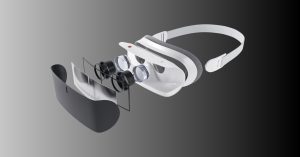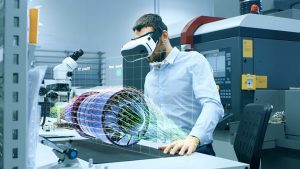Key Takeaways:
- Introduction to AR/MR/VR technologies offers an overview of Augmented Reality (AR), Mixed Reality (MR), and Virtual Reality (VR), explaining their immersive functionalities and real-world applications.
- The narrative delves into their roles in various industries such as automotive and medicine, detailing how they enhance training, design, customer experience, and medical procedures.
- Avantier’s contribution to the advancement of AR/MR/VR through precision optics underscores the importance of high-quality components for optimal performance in these technologies.
Augmented Reality (AR), Mixed Reality (MR), and Virtual Reality (VR) are all immersive technologies that allow users to experience digital content in new and interactive ways. How are optics for AR/MR/VR used in our lives? Here’s a brief overview of each technology:
Augmented Reality (AR) overlays digital content onto the real world, enhancing the user’s perception of reality. AR can be used on mobile devices, such as smartphones and tablets, to overlay information on top of the user’s view of the real world.
Mixed Reality (MR) is similar to AR, but it goes a step further by integrating digital content into the real world, so that digital objects can interact with real-world objects. This technology is often used in virtual training and simulation applications, as well as in gaming and entertainment.
Virtual Reality (VR) immerses users in a completely virtual world, where they can interact with digital objects in a more natural way. VR is typically experienced through head-mounted displays, which provide a 360-degree view of the virtual environment.

These three technologies are increasingly being adopted by the automotive industry for various purposes. For example, AR is used for training and simulation purposes, allowing mechanics and technicians to practice repairing and assembling vehicles in a virtual environment. VR is used in design and engineering, enabling designers to create and test new vehicle models in a simulated environment. MR combines both AR and VR, providing a more immersive and interactive experience for customers in showrooms or during test drives. MR can also be used for safety training, allowing drivers to practice emergency scenarios in a virtual environment. Overall, AR, VR, and MR have significant potential to transform the automotive industry by improving efficiency, reducing costs, and enhancing the customer experience.
In terms of future use in the medical market, all three technologies have great potential. For example, AR could be used to help doctors visualize medical imaging data, such as CT scans or MRIs, in real-time during surgical procedures. MR could be used to simulate medical procedures or to train medical students in a safe, controlled environment. VR could be used to help patients with anxiety or pain management by providing immersive and distracting environments. There are already many companies and organizations exploring these possibilities, and we expect to see more applications of AR/MR/VR in the medical field in the future.
Avantier is playing an important role in designing and manufacturing precision optics for AR/MR/VR devices to work effectively. Avantier produces high quality optical components (e.g. precision optical filters, prisms, beamsplitters, high performance camera lenses) that deliver high image quality and improve the accuracy and reliability of the tracking systems used in AR/MR/VR applications. Please contact us if you’d like to schedule a free consultation or request for quote on your next project.
GREAT ARTICLE!
Share this article to gain insights from your connections!




